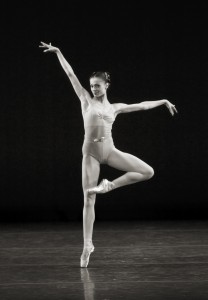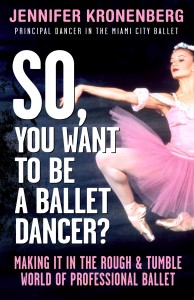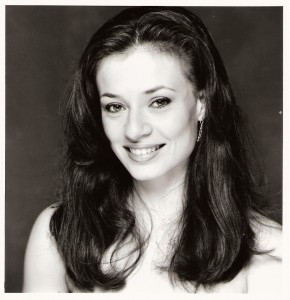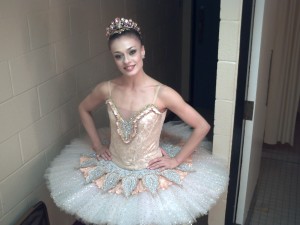Today on 4dancers we have 10 Questions With Jennifer Carlynn Kronenberg…

1. How did you get started in ballet and what are you doing now?
I always loved to dance, since a was a little girl, and I was always entranced by ballet in particular. I used to watch PBS “Dance in America” specials on TV and try to copy what I saw. My parents finally took me for lessons when I turned 8 years old. I knew I wanted to dance professionally, and I was fortunate enough to be contracted as an apprentice with the Miami City Ballet at the age of 17. I am still dancing with MCB now, and have been a principal dancer since 2001. I also teach annually for the CB School Summer Intensive and I have been a guest artist and teacher with several other schools around the country.
2. You have written a book – “So, You Want To Be A Ballet Dancer”. Can you tell readers what this is about?
My book is essentially a “how to” guide for young aspiring dancers who are considering a professional career. It is also, in part, a memoir in which I share stories of my own pre-professional struggles and mishaps. It is meant to be informational and inspirational at the same time.
I found that on my own way to becoming a professional, as I find now in students of my own, that there are so many essentials that go untaught; such as: the in’s and out’s of the stage and backstage, studio etiquette, auditioning skills, injury prevention, healthy diet and nutrition, stage makeup and hair, pointe shoe preparation and maintenance, handling criticism and stress, etc.
My goal is to provide some insight into these areas so that young dancers are ready to cope with these challenges before they are contracted into a company. All of the information I provide will prove useful in their continued years of study as well.
3. Who can benefit from reading this book—and why?
There is something in my book for pre-professional dancers and students of all levels and age groups. I provide standard information that every young dancer will find that they need to know later on, as well as advice and tips that they can use during their student years. I think it is so important to be well prepared to enter a company, and that being well prepared will ensure a start “on the right foot”. A career in ballet, as wonderful as it is, is full of challenge, dedication, frustration, and sacrifice. My goal is to ease young dancers’ transition from student to professional – even if it is just a little bit.
4. Can you share a piece of advice for young dancers?
The best advice I can give is to never ever forget what you love about dancing, and why you wanted to dance in the first place. Remind yourself each and every day. This will keep you motivated, dedicated and working hard, even on the toughest days, and can help you super-cede the toughest of challenges.
 5. One of the areas you talk about is the transition from student to professional. How was this a difficult one for you?
5. One of the areas you talk about is the transition from student to professional. How was this a difficult one for you?
It was difficult in many ways. First of all, I wasn’t accustomed to such a long and rigorous schedule; and though I had some performing experience, I didn’t know how to be part of the corps de ballet. I had so much to learn about the inner working of the theater, stage layout, basic backstage rules, etc.
Once you are in a company, everything happens so quickly, and nobody takes you by the hand to teach you necessary skills. You have to be extremely alert and pick things up along the way. I kept expecting someone to stop and explain everything to me and that never happened. If you want to get ahead, you need to be as prepared as possible from the start and be prepared to adjust to new working environment very quickly. For me, though very exciting, it was also intimidating and stressful.
6. What would you say is the most difficult part of being a ballet dancer at your level?
I think the most difficult part about being at this level is finding that it is still such hard work and I’m still never satisfied! Sometimes it is exhausting to know that so much is expected of me, all of the time, as an experienced principal dancer. I am still trying to progress and be better everyday.
I am still anxious before I go out on stage; though at this level no one expects me to be. I still struggle with some self doubt and insecurity, and that is hard to try and hide when you know people are looking up to you. There is always somebody watching – whether it be a student, and apprentice or young corps member, and it is my duty to always try to set a good example. That is a huge responsibility that I take very seriously.

7. How has the ballet world changed over the years?
Oh, the ballet world has changed in so many ways. Like everything else, it has advanced – the technical capabilities of today’s dancers are incredible, and there is always new and innovative choreography being created. Now, thanks to DVD and Internet connections, we are all exposed to different styles, choreographies and dancers and that is so inspiring! Sadly though, I don’t think it is as widely appreciated as an art form as it used to be, and there are some dancers who are still struggling just to survive. Many companies are suffering from economic difficulties and are lacking in public support.
8. What made you decide to write this book?
Actually, my husband Carlos (also a principal dancer) convinced me to do it. I love to write and had toyed with the idea of one day writing a book, yet I wasn’t sure what to write about. I’d come home from teaching and tell him how many questions the students were asking me, and how amazed I was that at that advanced level they were lacking certain basic skills. Finally he suggested that I write a book for them! I wasn’t sure about it, but once I started, I realized how much I had to say and how much I wanted to share, and it just took off from there.
9. What was the process of writing it like?
Actually, it was very long and tedious, but a lot of fun at the same time. I’m rarely satisfied with my own work (dancing included), so I wrote and rewrote things over and over. Part of the challenge was time. We have such a rigorous work schedule that it was hard to find adequate time to really sit down and concentrate on writing. Also, unbeknown-st to me, Carlos was announcing to everyone that I was writing the book before I had actually begun! I was a little bit hesitant about getting started, but once I found out that he was telling everyone, I had no choice but to get going!!!
10. What’s next for you?
I would love to keep teaching and even be a ballet mistress or coach. I also really want to keep writing. No matter what though, I need to keep a connection to the ballet world. It is what I love most and it helps define who I am.

BIO: Jennifer Carlynn Kronenberg was born in Queens, New York where she trained with Teresa Aubel, Nicholas Orloff, Norman Walker, and Barbara Walczack. She continued her studies on scholarship at the School of American Ballet before joining Miami City Ballet as an apprentice in 1994 at the age of 17. She moved steadily through the ranks and was named Principal dancer in 2001. Ms. Kronenberg has danced many leading roles; some of her favorites include Balanchine’s “Rubies”, Who Cares?, Allegro Brillante, Duo Concertante, Sonatine, Swan Lake, and Stravinsky Violin Concerto, as well as the classics – Grand Pas Classique, Coppélia, Don Quixote, Giselle, and John Cranko’s Romeo and Juliet. Ms. Kronenberg has been a regular teacher for the Miami City Ballet Summer Intensive Program for the last several years, and has also been a guest teacher with Ballet Arts of Jackson Tennessee, El Ballet de Monterrey Curso de Verano, New Orleans Center for Creative Arts, and Ballet Chicago, among many others.




